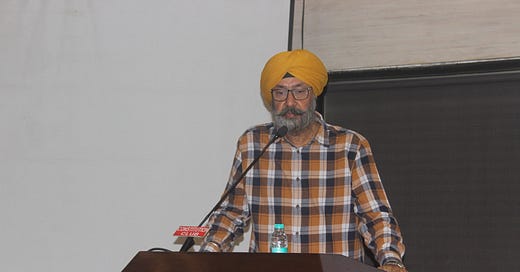Sikhs in and with India: 1947, 1966, 1984 — and Ever Onward
A Personal and Constitutional Reflection: June 1984 to Present.
🇮🇳 A Personal and Constitutional Reflection: June 1984 to Present
[Embedded Video Link – Speech at Constitution Club of India, 3 June 2025]
🕯️ Commemorating June 1984: A Moment of Remembrance
On 3rd June 2025, I had the honour of addressing an august but solemn gathering at the Constitution Club of India, New Delhi in a function organised by the Sikh Forum. The occasion was dedicated to paying homage to the innocent lives lost during the tragic events of Operation Blue Star in June 1984. This moment called not only for reflection but also for a reckoning—with history, with justice, and with the future of the Sikh community within the Indian Republic.
📜 The Year I Joined the IAS: A Personal Journey
My entry into the Indian Administrative Service in 1984 coincided with a year of deep anguish for the Sikh community. That confluence shaped much of my administrative life and moral compass. In this speech, I recount my journey through the evolving political and constitutional landscape of Punjab, beginning with the Rajiv-Longowal Accord, its eventual collapse, the subsequent Operation Black Thunder, and my tenure in Amritsar as Additional Deputy Commissioner (1990–1992) and then Deputy Commissioner (1992–1996). These years were marked by not just militancy and state response, but also grassroots resilience and democratic recovery.
🧭 The Sikh Voice in the Constituent Assembly
The speech moves from personal narrative to constitutional inquiry. I pose a foundational question: Did the representatives of the Sikhs in the Constituent Assembly actually sign the final draft of the Constitution of India? This is more than a symbolic doubt—it reflects a broader unease about whether the Sikh identity was ever fully acknowledged during the birth of the Republic. The answer, or lack thereof, continues to have political and emotional resonance even today. My answer is clear and categorical (see video).
📚 Minority Rights: A Constitutional Strength
India remains a rare democracy where certain Fundamental Rights are granted exclusively to minorities. I delve into Articles 29 and 30 of the Constitution, which enshrine the cultural and educational rights of religious and linguistic minorities. These articles are pillars of India's pluralistic ethos and provide a necessary shield to preserve distinct identities—especially that of the Sikhs, who have historically resisted assimilation.
⚖️ The Misunderstood Article 25
One of the most debated provisions in this context is Article 25, which deals with freedom of religion, untouchability issues with regard to entry into public religious places of worship. In 1982, coinciding with the Asian Games in New Delhi, prominent Sikh leaders publicly burned copies of Article 25, protesting the clubbing of Sikhism with Hinduism under its explanation. However, I argue that this protest may have missed the nuance of Explanation I, which explicitly recognises the right of Sikhs to wear the Kirpan as part of their essential religious practice. This is a constitutionally protected fundamental right—and an important legal acknowledgment of Sikh distinctiveness.
🏛️ The SGPC, Sikh Gurdwaras Act, and the Undefined “Sikh”
I also examine the definitional vacuum in the Indian Constitution, which does not define who a “Sikh” is. This lacuna creates complications, especially in relation to voting rights within the SGPC, which operates under the Sikh Gurdwaras Act, 1925. In the absence of constitutional clarity, legislative ambiguity continues to cause friction both within the community and between the community and the state.
🌾 Looking Ahead: Punjab’s Recovery Through Enterprise
Finally, I reflect on the economic and psychological challenges that Punjab faces today. From a once-thriving agricultural and industrial economy, the state now finds itself caught in a web of drug addiction, unemployment, and economic stagnation. I argue that the most effective remedy lies in fostering small-scale, indigenous entrepreneurship. This will not only revive economic health but also rebuild the spirit of self-reliance that once defined Punjab.
Though the speech is primarily delivered in Punjabi, it includes substantial portions in English and is easily understandable to Hindi-speaking audiences. I invite you to watch the video and reflect on the themes I have discussed—personal, constitutional, and national. Your feedback—whether shared publicly or privately—shall be most welcome.
By Karan Bir Singh Sidhu
Retired IAS Officer (Punjab Cadre)
Former Special Chief Secretary, Government of Punjab, with nearly four decades of public service.
Served in Key Administrative Roles across Punjab’s Border Belt, including as ADC, Amritsar (1990–92) and Deputy Commissioner, Amritsar (1992-96) (that included the present day Tarn Taran district).
Student of Sikh History, National Integration, Constitutional Governance, and Minority Rights





Very well atticulated Sir.. Sir kindly throw some light on how to develop MSMEs in Punjab